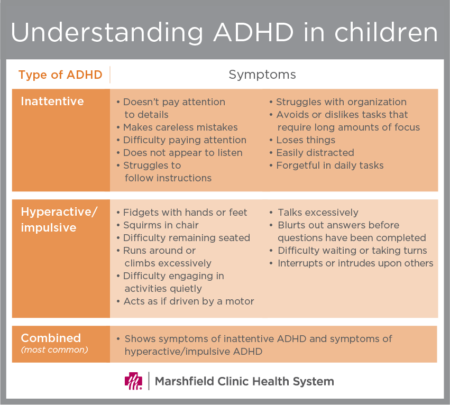
ADHD is one of the most common neurodevelopmental disorders of childhood. About 8% of children in the U.S. are diagnosed.
Why does my child squirm at the dinner table, rush through homework and interrupt people when they talk? These behaviors may be signs of attention-deficit/hyperactivity disorder (ADHD).
It is one of the most common neurodevelopmental disorders of childhood. About 8% of children in the U.S. are diagnosed with ADHD. Additionally, boys are more than twice as likely as girls to be diagnosed.
“All children can struggle to pay attention, sit still and manage impulsive behavior at times,” said Stacy Braun, a Marshfield Children’s child psychologist. “However, for some children, the difficulties become so great that they impact all aspects of their lives.”
Symptoms are generally present in early childhood. Children as young as 4 can be diagnosed. However, it is important to recognize ADHD symptoms from the inattentive, impulsive and active behavior typical for children under the age of 4.
Symptoms and Signs
Dr. Braun explained that ADHD is characterized by developmentally inappropriate levels of inattention, impulsivity and hyperactivity that gets in the way of daily life and learning.
To be diagnosed, a child must have a certain number of symptoms of inattention and/or hyperactivity and impulsivity for at least six months. These symptoms must show up in two or more settings (i.e., home, school).
This chart shows three major types of ADHD and the symptoms of each.

A full treatment for all three types typically includes learning about the diagnosis and treatment, behavioral techniques, parent training, medication, and school programming and supports.
For preschoolers with symptoms, we recommend parent training in behavior management before trying medication. For children age 6 and older, we recommend behavioral techniques along with medication.
“Effective management of a child’s symptoms can keep from developing more serious problems over time,” Dr. Braun said. “Additionally, parents can help identify their child’s strengths and build upon them so their child develops a sense of self-worth.”
Parents can educate themselves on ADHD, including their child’s educational rights at school. They can help advocate for their child at school. They can become an active part of the team that decides what supports and accommodations their child gets to help them succeed.
Parents may notice their child’s symptoms change as the child ages. Many children continue to have significant symptoms into adolescence and adulthood. However, it may look different as they age. As children enter adolescence, hyperactive and impulsive symptoms tend to fade away while inattentive symptoms tend to stick around.
Is it ADHD or something more?
Kids who appear to have ADHD may have other conditions causing their problems at school and at home.
A full assessment that includes medical, educational and psychological evaluations can help rule out other disorders that cause similar symptoms or often occur with ADHD.
If you believe your child may have ADHD, schedule an appointment with your pediatrician or a child psychologist.

